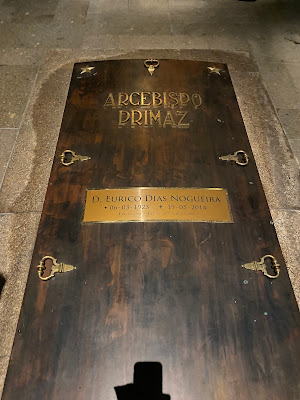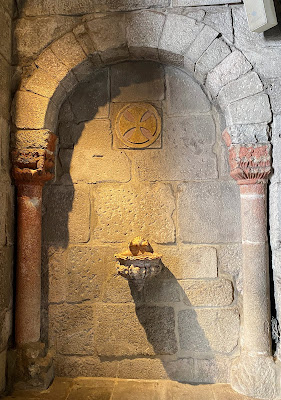July 1, 2022
Our Braga accommodations, the Hotel Vila Galé, was about a five-mile drive from the Bom Jesus Basilica. At first we couldn't find it. The address led us to this building, which was clearly (we thought), a church and not a hotel:
The hotel is enormous. Once we checked in at the front desk, we walked through a series of corridors for almost five minutes before reaching our room.
I like the different take on window framing--heads of purple cabbage.
Any hassle was more than made up for by our superb breakfast the following morning, a breakfast buffet as endless as the hotel's corridors.
We had other plans for the day away from Braga, so we didn't have a lot of time there. Besides sleeping (and eating), our main objective was the Braga Cathedral. I would have liked a little more time to wander in what looked like a charming city.
Of course, there are also plenty of the Portuguese specialty: beautiful azulejo tiled walls.
The nave and main altar were nice, with yet another spectacular double set of organ pipes reaching out over the seating and dating to the early 18th century.
But underneath the altar, just so you never forget, is the crucified, unresurrected body of Christ.
Another chapel with an interesting octagonal spider web-y ceiling . . .
. . . has a dramatic pietá as the centerpiece.
Like most cathedrals, there is a nice cloister, or covered walkway boarding an inner courtyard. I was drawn to this sculpture of John the Baptist with his interesting halo and ratty clothing.
I noticed that same halo style in other places.
This wood carving shows the Holy Trinity at the top (Jesus with the cross, the Holy Spirit in the form of a dove, and God the Father holding the globe). I'm guessing the woman on the left is Mary, and that is John the Baptist on the right.
There are a lot of images of Mary in her different roles: Mary with the Sacred Heart, pregnant Mary, and Mary, Our Lady of Fatima.
Joseph (with another of the unique halos) also gets another turn:
For me, however, the most spectacular aspect of the cathedral were the painted wooden (rather than plaster) ceilings. This is St. Peter Ratensis, the first Archbishop of Braga.
I think this ceiling was in the 15th century tomb of the Infant Afonso (1390-1400).
Afonso, the heir to the throne of Portugal, died at the tender age of 10. The bronze canopy over his tomb is especially beautiful.
The apostles look down on worshipers and tourists alike from their perches on the cathedral walls.
As an English speaker, I would NOT want to live on this street. Even when I ran it through Google Translate, I got "Street of the Fed Up" (although another source translates farto as "abundance.")
After a 5-7 minute walk, we arrived at the Braga Cathedral, home to the archbishop of Portugal and the oldest cathedral in the country. Parts of the building date back as far as the 1300s (some sources say the 1000s). The towers were added in the 1500s (and damaged by the huge 1755 earthquake). I've read that there is a saying in Portugal, "Older than the Braga Cathedral."
One of the first things we saw inside was the tomb of the most recently deceased archbishop and a list of all the Archbishops of Braga since the late 1400s.
It looks like most of them are entombed in the cathedral's crypt.A finely carved altar and the unusual wooden ceiling of the apse were two things that set this cathedral apart from others.
Close-up view of altar carvings of Jesus and the apostles:
The gilt lecturn was also quite unusual, as was what I think is a candle holder. (Too bad I cut off the top of the photo, but I must have been more intrigued by the castle base than the cold candle.)
There are many lovely side chapels. This version of Mary is beautiful, but I do feel sad for those disembodied baby angels she is standing on.
I like this one that includes a toddler Jesus and Joseph in the Holy Family.
But the best part is the angel with the scales of justice pulling souls out of hell/perdition.
I feel a little guilty for just strolling by these chapels with a "Oh, that's pretty," or simply, "Nice."
We do get to the point where we've been to so many churches that everything looks the same. But really, these are quite beautiful in their own right, and we never got tired of the "Stairway to Heaven" motif so popular in Portugal.
Ah, the beautiful azulejos. A Portuguese church just isn't complete without some.
I was sad that we didn't have more time for some of the other places in Braga. The Church of Santa Cruz (or "Holy Cross"), for example, looked intriguing. It was built between 1625-1637, with the towers added in 17353.
I doubt we will ever make it back to Braga, but you never know.







.JPG)
.JPG)


.JPG)
.JPG)



.JPG)





.JPG)



.JPG)

.JPG)








.JPG)






.JPG)


















I was a little disappointed with the cathedral in Braga. It had some fun elements, but I anticipated more and we ran into some other amazing cathedrals in Portugal. The hotel was kind of weird because it was so large and mostly empty, with huge walks to get to the front desk or breakfast room.
ReplyDelete